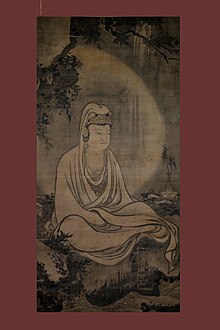Muqi
This article needs additional citations for verification. (May 2009) |
This article includes a list of references, related reading, or external links, but its sources remain unclear because it lacks inline citations. (May 2009) |

Muqi Fachang (1210?-1269?) (Wade-Giles: Mu-ch'i Fa-ch'ang) (Japanese: 牧谿 Mokkei) was a Chinese Zen Buddhist monk and renowned painter who lived in the 12th-13 centuries, around the end of the Southern Song dynasty. His surname is thought to be Xue; Muqi was a hao or pseudonym, and Fachang a monastic name. Muqi was perhaps from the city of Kaifeng in Hunan Province. Likewise, a possibility is Sichuan. A painting bears the inscription "monk from Shu(Sichuan)." He originally studied at the Wan-nian Monastery on Mt. Wutai. Muqi was doubtlessly drawn to the beauty of the West Lake in Hangzhou and refounded the abandoned monastery, Liutong Temple there in 1215. He is said to have been the disciple of Wujun Shifan (1178-1269). The monastery would have its place in the subsequent golden age of Chinese monochrome ink painting inspired by Chan (Zen) Buddhism. Muqi's masterpiece was the White-robed Guanyin (Japanese: 観音猿鶴図) preserved in the Daitokuji temple in Kyoto, Japan. This painting and others were to have a profound influence on the subsequent development of ink painting in Japan itself. Muqi's artwork covered a wide range of subjects, including portraits, landscapes, and still lifes. The aesthetic ideals of Muqi and other Zen Buddhist artists were overshadowed by the emerging litetati ideals of painting. Yet even in the early Ming period his works were copied as evidenced by the c. 1400s copy of the `White Robed Guanyin` reproduced with this article and now preserved in Japan.
BOOKS
- Toda Tadasuke, Mokkei and Gyokkan, Great Compendium of India Ink Paintings, vol. 3, Kodansha, 1973.
ARTICLES
- Shen Moujian, Encyclopedia of Chinese Artists (Zhongguo meishu jia renming cidian), Shanghai, p.540.
- Sickman and Soper, The Pelican History of Art, Middlesex, 1956, pp. 260-3.
- Jane Turner ed., The Dictionary of Art, Macmillan, 1996, vol. 22, pp. 325-6.
External links
